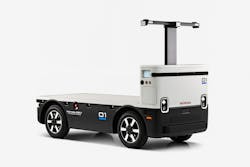Honda has released a third-generation prototype of its Autonomous Work Vehicle (AWV). It increased the bed size to hold two pallets and increased the loading capacity to 2,000 pounds. Lidar sensors were also added so the AWV’s autonomous navigational system will function in areas where HNSS service is weak or unavailable.
“We believe the Honda AWV can be a valuable solution to supporting construction teams while also enhancing worksite efficiencies and safety,” said Jason VanBuren, systems engineering manager, in a statement. “Leveraging Honda’s decades of experience developing reliable, safe and clean mobility technology, we aim to address issues such as labor shortages and improved environmental performance.”
The fully programmable all-electric Honda AWV can operate autonomously or by remote control.
Honda field tested the second-generation AWV at a large-scale solar construction site in the Southwest U.S.
Key features of the third-generation Honda AWV
- Increased bed size and loading capacity
- Improved navigation in locations where satellite system service is weak or unavailable
- Simplified tablet-based programming interface and cloud connectivity
- Higher speed in autonomous mode, up to 10 mph
- Increased battery size and longer operating time of up to 10 hours
- Enhanced avoidance function for vehicles stopped on road
- Lower bed for easier loading and improved ergonomics
The Honda AWV employs a suite of sensors to operate autonomously, using GPS for location; radar and lidar for obstacle detection; and cameras for remote monitoring. Previous field tests have also successfully verified that multiple Honda AWVs can transport and deliver construction materials and supplies at precise points along a pre-set route.
Honda AWV Specifications
- Operating weight: 1,765 lb.
- Max loading capacity: 2,000 lb.
- Battery: 18.6 kWh
- Range at max load: 28 miles
- Speed, autonomous/remote control: 10/2.5 mph
- Minimum turning radius: 11.4 ft.
Source: Honda
About the Author
Eman Abu-Khaled
Eman is an editorial intern at Endeavor Business Media.
